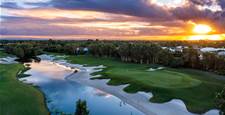Riverside Oaks has seen it all - boom, bust, and rebirth. From its star-studded 1980s debut to battling natural disasters, this iconic course remains a must-play, blending rich history with modern excellence, writes Brendan James of Snaphook Media.
The 1980s was the “big” decade. There were big developments, big plans from big-personality entrepreneurs, big shoulder pads, big hair and, most of all, there was big money.
Golf in this country wasn’t missing out, either. The biggest name in world golf was Greg Norman and whenever the Shark teed it up at home, the fans were 10-deep along each fairway he strode.
The game was thriving and developers looked to cash in on golf’s surging popularity by building golf courses with a resort or real estate attachment. In Queensland, the flag bearers for this boom were Palm Meadows and Sanctuary Cove, while further north in the tropics there was Paradise Palms and Mirage Port Douglas.
Sydney didn’t miss out, either.
In 1986, plans were announced for the development of Riverside Oaks on 600 acres of Hawkesbury River frontage at Cattai, about 90 minutes’ drive northwest of the CBD. The site had been home to the Paradise Gardens dinosaur theme park since the mid-1970s and there was also a nine-hole golf course on the property. These holes later became the foundation of the front nine of the new course.
The developer, Grahame Beach of Beachcorp, followed the script for the dizzying times and was not going to spare any expense in turning his vision for Riverside Oaks into a reality. He spent $15 million to acquire the site and begin construction on the course, which was designed by Ted Stirling and Bruce Hodson.
Beach revealed his plan to spend another $80 million to further developing the site to include corporate lodges, a second course, a tennis academy, marina and restaurant.
With the course nearing completion in 1987, Beach also signed a long-term agreement with the PGA of Australia to host the Australasian Tour’s Tournament of Champions, to be a regular venue for the Australian PGA Championship and to become the permanent home of the professional governing body.
It is almost 40 years since I first whacked a ball along the couch fairways at Riverside Oaks. Hundreds of rounds on from that rain-soaked media launch of the development in 1987, and it’s hardly surprising to state that much has changed.

Yet, there also remain aspects of playing a round at Riverside Oaks that are unlikely to ever change … thankfully. Despite its early history and, more recently, the significant impact of natural disasters, we can also be thankful this renowned venue has survived where many courses created in the same era did not.
The first public glimpses of the then-named PGA National Riverside Oaks came in March 1988 when Greg Norman teed up in the inaugural Tournament of Champions (TOC) event. The course was far from ready to host and with preferred lies in play, Norman – who arrived by helicopter for his tee time each day – streeted the field by eight strokes. The Shark played four events at Riverside Oaks in three years, winning two and was beaten in a play-off by Wayne Grady for the 1988 Australian PGA.
Despite its premature unveiling, Sydney’s newest course received accolades from players, including Norman and high-profile tournament imports Nick Faldo, Bernhard Langer and Ian Woosnam. A week later the layout welcomed its first paying customers, and the feeling was mutual.
There was plenty to like about the design, including some of its quirky holes, and
given time the couch fairways began to thrive. Like a sign of the times, Riverside Oaks boasted the biggest putting surfaces in the country, with the opening green a fine example at a whopping 3,680 square metres. And the quality of the bentgrass covering them was five-star smooth.

If only the next chapter in the Riverside Oaks story was as smooth.
In short, Beachcorp went into administration in 1992, and receivers later sold Riverside Oaks to a consortium of Australian and Japanese corporate interests. The course changed hands again before the end of the 1990s, with Riverside Oaks member and businessman Pat Cunningham taking over. In 2009, Cunningham sold the course to current owners, the Nanshan Group – a Chinese conglomerate with a broad spectrum of business interests across real estate, tourism, technology and, of course, golf.
By the time China’s largest golf course operator had been handed the keys to Riverside Oaks, the course was in desperate need of some TLC.
Nanshan’s impact on its newest acquisition was immediate with a significant investment made to improve the course presentation. The par-5 9th hole was also redesigned to create space for a full-length covered practice range, the absence of which had been a shortcoming to that point. Away from the golf course, renovations were made in the clubhouse and accommodation, while plans to build a second course and become Sydney’s only 36-hole club were revived.
The Bob Harrison-designed Bungool course, which covered land between the original layout and the eastern bank of the Hawkesbury River, opened for play in 2014 and within months it had joined its older neighbour – the then-newly named Gangurru course – in the ranks of the Top-100 Public Access Courses of Australia. Within two years, Bungool was also listed highly in the Top-100 Courses in the nation.
Harrison’s creation was a spectacular new addition to the resort, and it gained wide acclaim. He extracted the very best from the landscape, with such an extensive variety of holes. No two holes were remotely the same, and you never seemed to be reaching for the same clubs time-after-time.
Then, in March 2021, Bungool was inundated by floodwater when the Hawkesbury River burst its banks. A year later, almost to the day, the course was submerged again as heavy rainfall in the Sydney basin led to Warragamba Dam, 40km upstream from Riverside Oaks, spilling more than 70 gigalitres a day. In July 2022, Bungool was inundated for a third time in less than 18 months and the damage was major and extensive. The jewel in the Riverside Oaks crown has been closed ever since.
“Bungool being closed has hurt a lot in terms of being able to offer all the benefits of a 36-hole facility and we certainly have a strong desire to reopen it,” explained Riverside Oaks general manager Gary Dixon. “We have a loose timeline we are working towards, but there are still some hurdles to clear before it can reopen.
“It’s a special course which we can’t wait to put back into play.”
Bungool was (is) more than a special course. It was the perfect complement for the adjoining Gangurru layout. Bungool’s relatively wide fairways, punctuated by deep, strategically placed bunkering, laid across rolling sparse terrain was in stark contrast to Gangurru and its narrower playing corridors created by heavily tree-lined fairways on the front nine and menacing big water hazards on the back. For the visiting golfer, the Bungool-Gangurru combination offered a well-rounded golfing experience at the one address. And it will again.
In the meantime, Riverside Oaks’ original course continues to fly the flag and as previously mentioned, it continues to be a fun and challenging layout after all these years. But it is the much-improved conditioning of all the playing surfaces that impressed during my visit to compile this story. Course superintendent Danny Mclennan and his team have done a great job to raise the standard of presentation, which will ultimately help overcome a past reputation for being a little rough around the edges.
It still has a “big” feel about it, even if the putting surfaces are not quite as large as they were when Norman and Brett Ogle set the original course record back in the late-1980s. That said, the par-5 opening hole still finishes with one of the largest single greens you’re ever likely to see. The green is so broad that a putter might not be enough club to traverse the entire width, as it plays like a double green in one with a ridge splitting the left half from the right.
The rest of the front nine features medium-to-long par-4s at the 2nd, 3rd, 6th and 7th holes before heading into the scoring zone, where there are three relatively short par-5s in four holes from the 9th. Sandwiched in between is the picturesque 124-metre downhill par-3 11th hole, where the long green is perched just above the waterline of a lake. For such a short tee shot, it is a daunting one, with misses either side of the putting surface being penalised.
Water dominates the back nine and comes into play on every hole. While the S-shaped par-5 12th hole features three lakes on the journey from tee to green, it is a hole where players can still make par with a conservative strategy and passable ball-striking.
The same cannot be said for the 388-metre par-4 15th, where good ball striking is a prerequisite to walk off with a hard-earned par. The dogleg right has water lining the entire left side, demanding the tee shot needs to be shaped a little from left-to-right before a white-knuckle approach, with water short and left of the green and sand punishing those who timidly fan their shot to the right for fear of going in the drink.
The previously mentioned “big” feel you get playing at Riverside Oaks really kicks
in when you stand on the elevated 18th tee of the Gangurru layout and take in the view down the final fairway. The hole turns slight right around the edge of a beautiful
lake before straightening ahead of the large green that lies in front of the iconic
glass and concrete clubhouse.
It is a big stage worthy of big finishes, no matter whether it’s a two-putt for 36 points in the Saturday stableford comp, or Greg Norman is collecting silverware.
Related Articles

Course Review: Ranfurlie Golf Club

Review: Clearwater Golf Club

_15th_hole.jpg&h=600&w=850&c=0&s=1)



_15th_hole.jpg&h=115&w=225&c=1&s=1)








